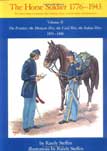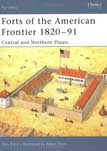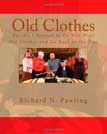

This is the second volume of a projected four-volume work. In Volume I the author delineated the uniforms, arms, accouterments, and equipment of the period from 1776 to 1850. In this volume he addresses himself to the eventful, bloody tragic mid-nineteenth century. Here he describes the dress and equipment of the horse soldier of the early frontier, the Mexican War, the Civil War, and the wars with the Indians. The uniforms, insignia, decorations, arms, and horse gear are described and profusely illustrated in three color plates and 126 black-and-white drawings. For his models the author used actual uniforms and equipment, supported by official government documents.
Among the subjects covered in this volume are the dress and equipment manufactured to meet the needs of cavalrymen at the early outposts east of the Missouri and in the brief War with Mexico that was a testing ground for the Civil War to come. (Ironically, much of the equipment and arms used by the United States Cavalry was designed by officers and government employees who later joined the Confederates.)
After the war came a new duty for the horse soldier—pacification of the hostile Indians of the West. As the needs of this harsh and demanding duty became clear, radical modifications were made to meet them. All these changes are described and minutely illustrated in this, the second volume of an indispensable reference work for American historians.
A major period of westward expansion took place in the United States during the first half of the 19th century. Fur trading, the coast-to-coast railroad, the California gold rush and the removal of Native American tribes both facilitated and encouraged America's "manifest destiny" to become a transcontinental nation. The task of protecting the settlers from the tribes that inhabited the Great Plains fell to the US Army, and to do this an extensive network of permanent forts was created via construction and acquisition. This title examines why the forts were built, as well as their design, defensive features and the role they played in the settlement of the American West. The daily lives of the garrison soldiers and fort inhabitants are also covered, together with the fighting witnessed at key sites.
This book is an indispensable guide to the often misunderstood field of living history. It presents the actuality that there is a great deal more involved in this discipline than merely “wearing old clothes and going back to the past.” This volume succinctly captures the perspectives that Richard Pawling has gained from over thirty-five years of experience in the interpretive profession (in county, state and national parks and as entrepreneur and owner of Rich Pawling’s History Alive!). Here, Pawling shares his observations and advice about everything from designing a living history persona to his successful use of this provocative teaching technique in the college classroom, to the role of research in helping you to learn about your own genealogical past. Though written for a broad audience, this book should be of particular interest to those employed as an interpretive park ranger or a naturalist, a museum or tour guide, or those who volunteer as a military reenactor or as a docent at a park, museum or historic site. Old Clothes presents the important lessons Pawling has learned along the way, the most important of which is that “life is a journey and understanding our past plays an important role in helping us to continue to learn not only about life in general, but more importantly, about ourselves.”
Etienne Aubert elected as Pope Innocentius VI
Admiral Steven van der Haghens fleet departs to East-Indies
English parliament accept unanimously, Protestation
Empress Maria Theresa expels Jews from Prague, Bohemia and Moravia
English King George III fires government of Portland
New Jersey becomes 3rd state to ratify constitution
1st US newspaper to appear on Sunday (Baltimore Monitor)
British take Ft Niagara in War of 1812
Charles Darwins visits Vurland
1st celestial photograph (of Moon) made in US, John Draper, New York City
William Bond obtains 1st photograph of Moon through a telescope
Passy, at Paris: 1st "Samedi soir" i / d villa of lovers Rossini
South Carolina declared an "independent commonwealth"
13th Amendment ratified, slavery abolished
1st US cattle importation law passed
French SS Byzantin sinks after collision in Dardanellen, 210 killed
Lugards expedition to Mengo / Kampala, Uganda
Automobile speed record set-63 km/h (39 mph)
Field Marshal Lord Roberts appointed British Supreme Commander in South Africa
H V Hordern takes 8-81 in 2nd innings of F-C debut (New South Wales vs. Queensland)
President Wilson, widowed the year before, marries Edith Bolling Galt
Soviet regiment (Stalin / Lenin) declares Finland Independent
1st US postage stamps printed without the words United States or US
International zone of Tangier set up in Morocco
Bradman scores 258 NSW vs. South Australia, 289 mins, 37 fours
Chicago Bears beat Portsmouth Spartans 9-0 in 1st NFL playoff game
Edward Benes becomes President of Czechoslovakia
1st giant panda imported into US
Su-Lin, 1st giant panda to come to US from China, arrives in San Francisco
German submarine U-434 sinks
Japanse troops land on Hong Kong
Destroyers "Hull, " "Spence" and"Monaghan" sink in typhoon (Philippines)
Nazi occupiers of Amsterdam destroy electricity plants
Uruguay joins UN
Pope Pius XII publishes encyclical Optissima Pax
WDSU TV channel 6 in New Orleans, LA (NBC) begins broadcasting
Philadelphia Eagles beat LA Rams 14-0 in NFL championship game
Ellis W Ryan resigns as Cleveland Indians President
KATV TV channel 7 in Little Rock, AR (ABC) begins broadcasting
KMID TV channel 2 in Midland and Odessa, TX (ABC) begins broadcasting
Japan admitted to UN
Phil Rizzuto signs as New York Yankee radio-TV announcer
"To Tell the Truth" debuts on CBS-TV
Israeli flag hoisted on Mount Sinai
Shippingport Atomic Power Stn, 1st nuke plant to generate electricity
1st test project of Signal Communications by Orbiting Relay Equip
1st voice from space: recorded Christmas message by Eisenhower
Niger gains autonomy within French Community (National Day)
Sammy Baugh named 1st coach of New York Titans (AFL)
General Meeting of the UN condemns apartheid
For 2nd cons year, AP names Wilma Rudolph female athlete of year
India annexes Portuguese colonies of Goa, Damao and Diu
KAIL TV channel 53 in Fresno, CA (IND) begins broadcasting
Wilt Chamberlain of NBA Philadelphia Warriors scores 78 points vs. LA
WAIQ TV channel 26 in Montgomery, AL (PBS) begins broadcasting
Clarke runs world record 10k (28:15.6)
"I Had a BaIl" opens at Martin Beck Theater NYC for 199 performances
"The Pink Panther" cartoon series premieres (Pink Phink)
During services held for Sam Cooke fans caused damage to Funeral Home
"La Grusse Valise" closes at 54th St. Theater NYC after 7 performances
Borman and Lovell Splash down in Atlantic ends 2 week Gemini VII mission
Kenneth LeBel jumps 17 barrels on ice skates
"Coco" opens at Mark Hellinger Theater NYC for 333 performances
"Me Nobody Knows" opens at Helen Hayes Theater NYC for 587 performances
Polish uprising fails
1st Candlelight Processional
CBS radio cancels Saturday morning band concerts
People United To Save Humanity (PUSH) forms by Jesse Jackson in Chic
US begins its heaviest bombing of North Vietnam
Soyuz 13 launched into Earth orbit for 8 days
Yanks sign Dick Williams as manager, overturned later by AL President
San Francisco Visitors Center at City Hall opens
"A Star is Born, " with Barbra Striesand, premieres
"Wonder Woman" debuts on ABC
Soviet dissident Viktor Bukovskiexchanged for Chile CP-leader Corvalan
Cleveland Cavaliers retire jersey # 42, Nate Thumond
Dutch Antilles: Premier Boy Rozendal points independence off
Stanley Barrett 1st to exceed land sonic speed (739.666 mph)
Dutch 2nd Chamber accepts Minister Van Agts abortion laws
Vietnam adopts constitution
NBA San Diego Clippers ends 29 game road losing streak
73rd Davis Cup: Sweden beats USA in Gothenburg (4-1)
UN Security Council unanimously condemns "acts of hostage-taking"
Mr Gates, serves as acting Director of CIA
Ivan F Boesky sentenced to 3 years for insider trading
5th meeting of Giants-Jets, Jets win and eliminate Giants from playoffs
Seattle Seahawks win their 1st ever division title with 9-7 record
"I Love Lucy" Christmas episode, shown for 1st time in over 30 years
NL announces Buffalo, Denver, Miami, Orlando, Tampa-St Petersburg, and Washington DC as 6 finalist for 1993 expansion (Miami & Denver win)
NL releases short list of teams for 1993 NL expansion
DeForest Kelly (Dr McCoy on Star Trek) gets a star in Hollywood
General Motors announces closing of 21 plants
FCC vote 4-1 to allow Infinity to purchase Cook Inlet stations
Kevin Scott skates world record 1K (1:12.54)
"Comedy Tonight" opens at Lunt-Fontanne Theater NYC for 8 performances
Darryl Strawberry pleads not guilty on tax evasion charges
General Hospital stars Kristina Malandro and Jack Wagner wed
Socialist Party (ex-communist) wins Bulgaria parliamentary election
TV industry execs agree to adopt a ratings system


